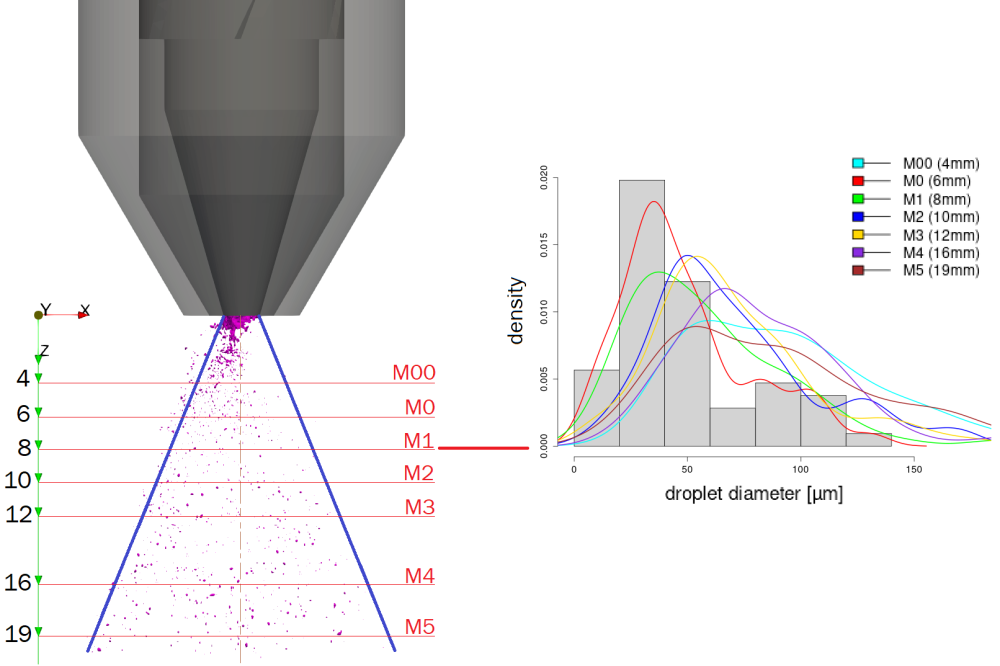High Fidelity Numerical Simulations of Atomization Process for Two-Fluid Nozzles
Introduction
Spray drying is one of the most used manufacturing techniques by the pharmaceutical industry. It enhances the bioavailability of a crystalline drug through the formation of Amorphous Solid Dispersions (ASD). The ASD is formed by active pharmaceutical ingredients (API) and a polymer matrix; they are mixed with a solvent and supplied to a nozzle which atomize them into a drying chamber. Conventionally, experimental studies are carried out to qualitatively and quantitatively capture system features, such as the droplet size distribution. Nonetheless, there are two key aspects which limit the extent on which experimental measurements can retrieve operational characteristics: the multiscale nature of the system and the measurement resolution.
Direct numerical simulations (DNS) offer a feasible solution in the detailed study of the atomization process. Thanks to high performance computation it is possible to perform such simulations to tackle down Multiphysics, multiscaling and problem size complications, which are enhanced by the small size of the droplets generated from the atomization. In this project, the characterization of the atomization process for a commercial two-fluid nozzle was performed to obtain a deep understanding on the functioning of the system, posing the analysis to an analytical function correlation between dimensionless numbers and the Sauter mean diameter (SMD).
Methods
The development of a numerical tool by means of the computational fluid dynamics toolbox OpenFOAM (Open-source Field Operation and Manipulation) served as main resource to perform the high fidelity simulations on the Lichtenberg 2 cluster for this project. This numerical tool is based on a embedded large eddy simulation (LES) / direct numerical simulation (DNS) approach in conjunction with the usage of the LES-Sigma model applying non-equilibrium wall functions, developed at the RSM institute. The “InterIsoFoam” library from OpenFOAM guaranteed the incompressible, multiphase solution of the system; implementing the volume of fluid (VOF) approach coupled with the IsoAdvector scheme to tackle down the multiphase flow. Simulations results were post-processed by means of R-Project.
Results
In this Project, a commercial two-fluid nozzle characterization was achieved by the development of a numerical tool to predict the spray atomization process of the nozzle. To evaluate such tool, a design of experiments (DOE) methodology, based on the operational parameters of the spray dryer, derived into 68 high fidelity numerical simulations on the Lichtenberg HPC. Post-processing and statistical analysis of the data concluded in the obtaining of: characteristic fluid flow model of the nozzle operation, the spray morphology identification, the distinction between two main atomization regimes within the operational boundaries conceived in the DOE, and an accurate correlation function for the prediction of the Sauter mean diameter.
Discussion
An accurate function correlation for the Sauter mean diameter was obtained as result of the analysis of the high fidelity simulations. This correlation predicts the atomization under different operational regimes, which cover a bimodal (incomplete atomization) and a unimodal (complete atomization) droplet size distribution. The order of predicted droplets match experimental analysis of the spray drying system nozzle. Further investigations on the concrete validation of the numerical results obtained on this project are being carried on. Although, a 2D sampling methodology for the capturing of the atomized droplets has been applied, a more detailed analysis based on a 3D tool is necessary to increase the accuracy on the most unsteady regimes of the nozzle operation.




